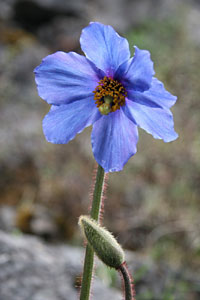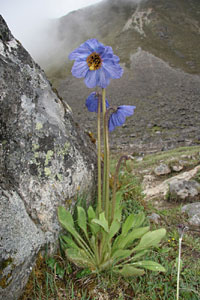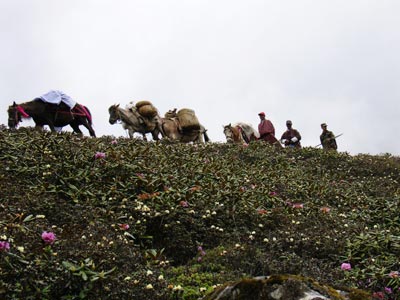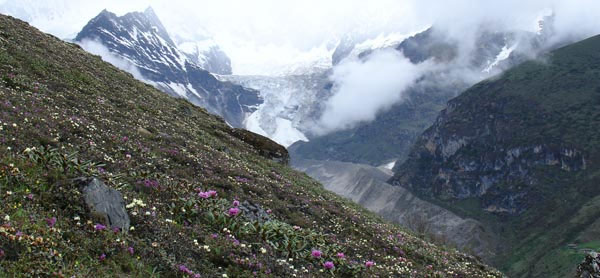Travellers' Tales :: In Search of the Blue Poppy
This feature appeared as cover story for Tashi Delek, the inflight magazine for Druk Air (Bhutan). Cover photograph by Michael Buckley.
In Search of the Blue Poppy
Text and photos by Michael Buckley
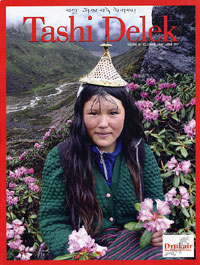
The blue poppy, Bhutan's national flower, grows the rocky terrain above the tree line. At one time like the yeti it was considered a myth because its existence was not confirmed. George Sherriff, a British botanist, found the plant in the remote mountain region of Sakteng in eastern Bhutan.
Monsoon in Bhutan means slippery trails, high rivers, bridges washed away, biting gnats—and leeches. But it also means blue poppies. The only time they flower is during the annual monsoon rains, from May to July. The blue poppy is the national flower of Bhutan, but that doesn't mean you'll have an easy time finding one.
And this is what I have set my heart on doing: finding the rare blue poppy in its remote high-altitude mountain habitat. Inspiration comes from reading accounts of early 20th-century Western plant hunters who came to the foothills of the Himalayas in search of gems like the blue poppy as ornamental flowers for European gardens.
Although the blue poppy was identified as early as the 1850s, it was not until 1913 that British explorer Eric Bailey plucked one in the Tsangpo region of eastern Tibet and pressed it between the pages of a notebook. The specimen was named Meconopsis betonicifolia baileyi after him: it aroused considerable interest in Britain. Bailey was a butterfly collector, not a botanist. Following directions given by Bailey, botanist Frank Kingdon-Ward collected seeds in 1924 and is credited with introducing the blue poppy to European gardens.
It was Bailey again who discovered a huge white poppy (Meconopsis superba) while riding into Bhutan through the Ha district in 1922. But the blue poppy remained elusive—its presence in Bhutan was not confirmed until 1934 when British botanist George Sherriff collected specimens in the mountains of Sakteng, to the far eastern border of Bhutan. This variety is known as Meconopsis grandis, today the national flower of Bhutan. The seeds that George Sherriff sent back to England flowered in cultivation, and not only that—they cross-fertilised with other species, producing new blue poppy hybrids. In the wilds of Bhutan, the different poppy species rarely 'meet', so natural hybrids are rare.
Five of the dozen blue poppy species growing across the Himalayas are found in Bhutan. They range from smaller varieties in high meadows to taller varieties that grow above the tree line in high-alpine scree. Other rare poppies sighted in Bhutan include the white poppy, the red poppy and the yellow poppy.
One advantage of trekking in monsoon season quickly becomes apparent: you have the entire trail to yourself. Because of a late monsoon arrival, we get a terrific bonus: the rhododendrons are still out in full force. They present a glorious sight as they carpet entire mountainsides with varieties ranging from tiny to tree-sized, including the beautiful red-flowering ethometho. Close to 50 species of rhododendron have been identified in Bhutan, with one endemic species. When the rhododendrons are in flower, Bhutan turns into a plant-lover's paradise. In fact, the entire country of Bhutan can be considered to be one great garden. While neighbouring Tibet and Nepal are under threat from large-scale deforestation, Bhutan has preserved its great forests intact. Over 6,000 plant species have been identified in Bhutan, including an astonishing 360 orchid species.
After several days of arduous trekking on slippery slopes, our small trekking party reaches 3,500 metres, the merciful elevation where the bugs disappear. By the time we get to Chomolhari basecamp, most plant species have disappeared too. The trees are long gone. The only plant life that flourishes here consists of mosses and lichens.
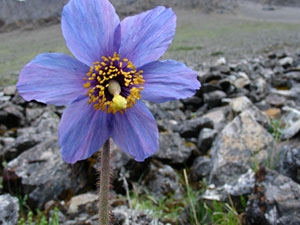
Climbing up to a high-altitude lake at 4,100 metres, we sight blue sheep and ruddy shelducks. A mist descends over the lake, reducing visibility. And then, out the corner of my eye, I spot a lone flower—a turquoise gem. In such a bleak setting, the blue poppy is a fantastic sight. It stands a metre tall, jutting out of alpine scree, with snowcapped peaks looming. You wonder how the plant could possibly survive such extreme conditions, let alone produce a gorgeous deep-blue flower. But this is a hardy alpine poppy, able to withstand freezing temperatures.
Another day of trekking brings us over a high pass to Lingshi, which is famed for its huge variety of mountain flowers and herbs. Botanists and flower lovers come from as far afield as England or Japan to see these floral wonders. We run into some Bhutanese collectors, looking for medicinal varieties for the Institute of Traditional Medicine in Thimphu. With over 200 medicinal plants identified in Bhutan, they have plenty of work to do.
High on the hillsides above Lingshi, my sharp-eyed guide points in excitement to a clump of vegetation. He has found not one blue poppy, but an entire cluster of them. One large specimen bears nine petals. It is a thrilling sight: I feel privileged to witness such fleeting beauty. The blue poppy's frailty lies in the fact that this variety flowers only once, then seeds and dies. But there is one way to make the bloom last—by capturing it on film. Perhaps the photos on these pages will convey a little of Bhutan's extraordinary wealth of flora, but nothing can surpass seeing it for yourself.

POSTCARDS FROM BHUTAN

